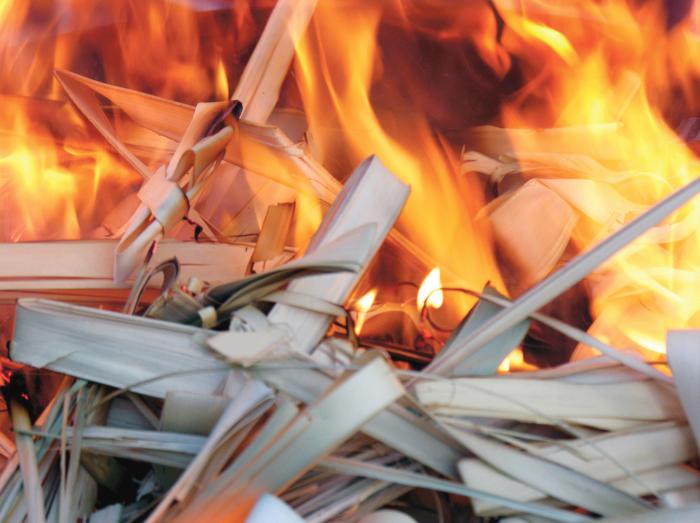Local
Ash Wednesday is more than just ashes
By Donis Tracy Pilot Correspondent
Posted: 2/24/2017


Palms are burned for ashes used to mark the start of Lent on Ash Wednesday. The penitential season of Lent calls Christians to prayer, fasting, repentance and charity. CNS file photo/Bill Wittman
Walk through any school, supermarket, subway or shopping center next Wednesday and you are likely to find Catholics marked with the sign of the cross in dark ashes on their forehead. Ash Wednesday -- the beginning of the season of Lent.
"The imposition of ashes is not just a simple rite, but it is something very profound that touches our hearts," said Father Lukasz Wisniewski, vice-rector of the Redemptoris Mater Archdiocesan Missionary Seminary in Brookline. These ashes, according to Father Wisniewski, are made from either burning olive branches or the palms blessed the previous year on Palm Sunday.
But where does the tradition of receiving ashes at the beginning of Lent originate?
"At first, this rite was not directly connected with the beginning of Lent," explained Father Wisniewski. "This custom is an ancient penitential practice common among the Hebrew people." He pointed to several instances in the Old Testament when people use sackcloth and ashes, including the city of Ninevah in the book of Jonah, to demonstrate their repentance.
According to Father Wisniewski, during the 7th century, ashes were "used as part of temporarily expelling public sinners from the community of believers for sins like apostasy, heresy, murder and adultery."
Once public sinners had spent 40 days repenting for their sins, living apart from the community, they received sacramental forgiveness and were then led back into the assembly by their bishop.
"During the Middle Ages, this rite of placing ashes on the head was adopted by all members of the parish," he continued, adding that the sign was a way of publicly beginning the season of Lent.
"(The ashes) help us to understand the words of the prophet Joel, which we will hear during the Ash Wednesday liturgy, where he says, 'Rend your hearts, not your garments, and return to the Lord our God."
"What really counts is to return to God with a contrite heart to receive his mercy," Father Winsewski said.
He pointed not only to the rite of the imposition of ashes, but also to "the Liturgy of the Word, and the proper texts of the Mass, such as the Collect, the prayer over the people and the chants of the Mass" as prayers that help deepen our relationship with God.
"Ash Wednesday is a day when in the midst of our daily struggles we have a possibility to stop for a moment and hear the subtle voice of Christ say, 'Come back to me.' Is this return to God possible? Yes," he said.
He noted the Collect of the Mass of Ash Wednesday calls the faithful to "take up battle against spiritual evils," and to be "armed with weapons of self-restraint."
"This shows us another aspect of Lenten spirituality," he said. "The Church wants to remind us that our daily life -- Christian life -- is a battle. Every day we struggle to discern, recognize and fulfill the will of God."
He noted that the Church has always stressed the need for prayer, fasting and almsgiving during the season of Lent.
"This is the best weapon we need in this battle," he said, noting that Saint Augustine called fasting and almsgiving the "two wings of prayer."
"Do you want God to hear your prayers," he asked. "Then fast and give alms."
However, he pointed out that Ash Wednesday and Lent should not be viewed as a "dark season because of its sadness and severity."
"On the contrary, the splendor of Christ's Resurrection already gleams. Ash Wednesday lets the rays of this light pass through the gloom in our hearts," he stressed. "Here before us are 40 days where we can taste the generosity of Christ, which will culminate in the Paschal victory on Easter Sunday."